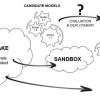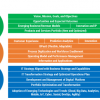Business Transformation Requires Transformational Leaders
Leadership and teaming skills are front and center in times of rapid change. Meet today’s constant disruption head on with expert guidance in leadership, business strategy, transformation, and innovation. Whether the disruption du jour is a digitally-driven upending of traditional business models, the pandemic-driven end to business as usual, or the change-driven challenge of staffing that meets your transformation plans—you’ll be prepared with cutting edge techniques and expert knowledge that enable strategic leadership.
Recently Published
While other strategies can to some extent be seen as alternatives, information superiority is different; it should be implemented in combination with any of the other options, serving as a “booster” of competitive advantage. In this Executive Update, we propose possible scenarios for the implementation of information superiority strategy, which provides relatively high sustainability without introducing too much complexity.
The articles in this issue present perspectives and ideas on business transformation in the digital age. We hope they will inspire and encourage you to visualize the likely future of business in your domain and to explore the opportunities it presents. Finally, we hope their insights will help you identify suitable transformation strategies and plans and, if needed, choose viable collaboration models for partnering with startups and other firms in your digital business efforts.
The financial services sector was one of the first to be impacted by digitization, and for many years, banks (and also insurers) have been innovating their offerings to respond to the increasing demands of customers, changing regulations, and heightened competition. But the real disruption — which has changed banks’ business models and the way they interact with consumers — began with the emergence of fintech. Increasingly, small, nimble, technology-savvy companies are unbundling the offerings of traditional banks; consider online lenders that provide loans to customers who, due to strengthened credit criteria, have lost access to conventional bank loans, or remittance companies that allow customers to send money abroad at the fraction of the cost charged by banks. In recent months, the trend has been observed even more strongly in the insurance space with the rise of insurtech, which impacts the whole insurance value chain, from customer onboarding, through risk assessment, to selling the products, and finally to claims processing. Digital transformation has become inevitable, and banks and insurers are looking for the most efficient strategies for the digital age.
Big data, the Internet of Things (IoT), and the cloud are technological innovations that need to demonstrate corresponding business value. While the aforementioned technologies have distinct identities of their own, they are also interdependent. Innovating with these technologies at a business level demands a multidisciplinary, holistic approach that also incorporates an understanding of how to manage risks. The Big Data Framework for Agile Business (BDFAB) provides a basis for fostering innovation and managing the risks associated with it in the big data, IoT, and cloud space. This article discusses the nature of innovation in the context of big data, IoT, and the cloud and its application in practice.
The business environment is changing at a faster rate than ever before. One of the drivers of change is clearly technology, which is disrupting business at multiple levels. Within the organization, technology is disrupting business processes and the roles people play. Outside the organization, technology is enabling new business models, leading to new forms of competition. Today’s customers have much more access to technology and devices, and they expect to use those to interact with businesses. They also expect businesses to offer more sophisticated, smarter products and services tailored to their needs and preferences.
In this article, I discuss key drivers for adoption of digital business, propose a framework organizations can use to guide their digital transformation efforts, and consider the value digital transformation is delivering in areas of healthcare, travel, and government.
This article examines the impact of digital technologies, including virtual reality (VR), on the sharing and archiving of life events and explores the potential business opportunities that are apt to arise from these technologies. It also seeks to illustrate, through exploring the impact of disruptive technologies on the photographic industry, the lessons to be drawn when either tackling the technological challenges in a long-established traditional business or seeking to create a new market opportunity enabled by disruptive technologies.
Toward Collaborative Leadership
As an executive coach, I continuously hear new clients say, "All I want are results. Is it too much to expect people to deliver on their commitments?" After a few minutes of additional dialogue, we typically discover several organizational, technical, and managerial challenges that have culminated in some noticeable and negative result. In other words, I'm being asked to fix a problem that has escalated to a level that is no longer tolerable to those in leadership.

















